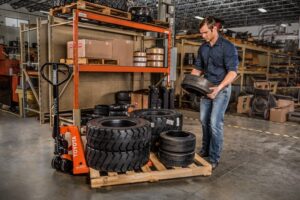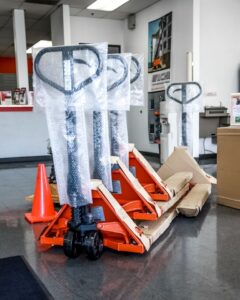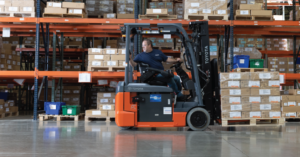Archive for July, 2023
How To Use a Pallet Jack the Correct Way
If you work in a warehouse, distribution center, or any industry dealing with heavy loads, chances are you’ve encountered a pallet jack. Also known as a pallet truck, hand pallet jack, or pump truck, this versatile tool moves and transports pallets efficiently and safely. Whether you’re a novice or an experienced operator, this comprehensive guide will provide step-by-step instructions about using a pallet jack effectively.
Step 1: Familiarize Yourself with the Pallet Jack
When you use a pallet jack for the first time, take a moment to familiarize yourself with its components:
- Handle: The long, vertical handle allows you to maneuver the pallet jack.
- Pump Lever: The pump lever near the handle raises and lowers the forks.
- Forks: The two parallel prongs that go beneath the pallet to lift and carry it.
- Load Wheels: The small wheels located on the front edge of the forks that support the weight of the load.
- Steer Wheels: The larger wheels at the rear of the pallet jack help with steering.
Step 2: Ensure Safety First
Safety should always be your top priority. Before using the pallet jack, follow these safety measures:
- Ensure the operators learning to use a pallet jack are trained and competent. Provide operator training before teaching someone how to use a pallet jack. It’s an OSHA requirement. If you’re in Los Angeles County, sign up for forklift operator safety training in Santa Fe Springs or inquire about training at your location. We offer forklift safety training classes in English and Spanish.
- Wear appropriate personal protective equipment (PPE) such as safety shoes and gloves.
- Inspect the pallet jack for any damage or defects. Ensure the wheels are in good condition and the forks are not bent or cracked.
- Check the load capacity of the pallet jack and ensure the load you’re about to move does not exceed it.
- Clear the path of any obstacles or debris that may hinder your movement.
Step 3: Positioning and Loading the Pallet Jack
Now that you’re ready to use the pallet jack follow these steps to position and load it correctly:

- Position the pallet jack at the side of the pallet. Align the forks with the gaps between the pallet boards.
- Make sure the forks are fully inserted into the pallet to ensure stability.
- Adjust the width of the forks to match the width of the pallet.
- Ensure the load is evenly distributed on the pallet to maintain balance and stability.
Step 4: Lifting and Moving the Pallet Jack
With the pallet jack properly loaded, it’s time to lift and move the load:
- Stand behind the pallet jack and firmly grasp the handle.
- Pump the lever to raise the forks off the ground. Use smooth and even motions.
- Push the pallet jack forward once the forks reach the desired height, using your body weight to steer it.
- Turn the handle in the desired direction while maintaining a steady pace to change direction.
- Slow down or stop the pallet jack gradually to avoid sudden jolts that could compromise the load’s stability.
- Use caution when approaching corners or narrow spaces to prevent accidents.
Step 5: Unloading the Pallet Jack
When it’s time to unload the pallet, follow these steps:
- Position the pallet jack in front of the desired location for unloading.
- Slowly lower the forks by operating the pump lever, keeping an eye on the load, and ensuring it is stable.
- Once the load is safely on the ground, carefully remove the forks from beneath the pallet.
- If necessary, secure the unloaded pallet using straps or other appropriate means.
Mastering a pallet jack can significantly enhance your efficiency and safety when handling heavy loads. By following these step-by-step instructions and practicing good safety measures, you’ll know how to use a pallet jack and perform like an expert in no time. Always prioritize safety, regularly inspect your pallet jack, and seek professional training if necessary. Happy pallet moving!

At Toyota Material Handling Solutions, we take pride in offering a wide range of reliable and high-quality pallet jacks for sale for various industries. Our selection includes renowned brands such as Toyota, Tora-Max, Heli, and Noblelift, ensuring you can access the best equipment for your specific requirements. Contact us to get a list of new pallet jacks for sale.

 Since your forklift operators are using the equipment every day, ask them to watch out for the following issues:
Since your forklift operators are using the equipment every day, ask them to watch out for the following issues: